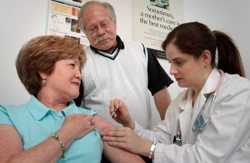How to Prevent Flu from Spreading

If you have cancer now or have had cancer in the past, you are at higher risk for complications from the seasonal flu or influenza, including hospitalization and death. Follow these steps to reduce your risk of getting the flu or spreading it to others.
- Take time to get a flu vaccine.
- Develop good health habits to stop the spread of germs.
- Cover your nose and mouth with a tissue when you cough or sneeze. Throw the tissue in the trash after you use it.
- Wash your hands often with soap and water. If soap and water are not available, use an alcohol-based hand sanitizer.
- Avoid touching your eyes, nose, or mouth. Germs spread this way.
- Try to stay at least six feet away from people who appear ill.
- If you are sick with flu-like illness, stay home for at least 24 hours after your fever is gone except to get medical care or for other necessities. Your fever should be gone without the use of a fever-reducing medicine. Keep away from others as much as possible to keep from making them sick.
-
Follow public health advice regarding school closures, avoiding crowds, and other social distancing measures.
- Be prepared in case you get sick with a supply of over-the-counter medicines, alcohol-based hand sanitizer, and tissues.
-
Take flu antiviral drugs if your doctor prescribes them.
Other important steps to take include—
- Stay informed by visiting CDC’s Flu site often.
- Develop a plan in advance with your doctor about what to do if you get sick (when you should call your doctor, whether you will need antiviral medication, and how to get a prescription for antiviral medication quickly if needed).
- Make sure your vaccinations are up-to-date.
- Keep a written record of the type of cancer you have, treatment you have received and when you received it, the name and contact information for your doctor, and a list of medicines you are taking.
- Page last reviewed: July 30, 2014
- Page last updated: September 26, 2017
- Content source:


 ShareCompartir
ShareCompartir